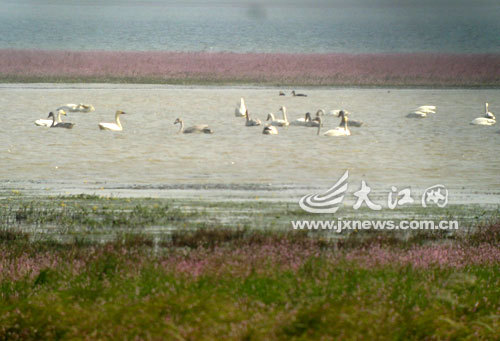Poyang Lake's migratory birds to get food drop
 0 Comment(s)
0 Comment(s) Print
Print E-mail
Xinhua, January 11, 2012
E-mail
Xinhua, January 11, 2012
Authorities at Poyang Lake plan to deploy a helicopter to distribute feed to more than 500,000 birds as a severe drought has shrunk China's largest freshwater lake and is threatening birds there for the winter.
 |
|
East China's Poyang Lake, a major winter destination for birds in Asia, had more than 500,000 birds of 52 categories. |
The first air delivery will start before the Spring Festival, or Chinese New Year, that falls on Jan. 23, to ensure that birds will not starve for the rest of the winter, said Wu Heping, a senior official at the Poyang Natural Reserve.
East China's Poyang Lake, a major winter destination for birds in Asia, had more than 500,000 birds of 52 categories, including endangered species such as hooded cranes and white-naped cranes, as of December, 2011.
But as this year's extended dry season has shrunk the lake to less than 200 square km, or 5 percent of its full size, ornithologists are worried about the birds that feed on plankton, fish and waterweed in the lake and its nearby wetlands.
"About 60 percent of swan geese and 98 percent of white cranes in the world fly to Poyang for the winter, but they are now threatened by shrinking food supply and habitat," said Zuo Quan, employed at the Poyang Natural Reserve that locates in the Jiangxi Province.
Traditionally, feed was distributed by reserve staff members in times of disastrous snowstorms. But manual distribution has been difficult this year, as the massive shrinkage of Poyang has forced the exodus of birds into nearby smaller lakes and even farmlands, said Wu.
"About 200,000 birds, or half of the flock, have flown to the nine satellite lakes of Poyang, and their expanded habitat is the main reason we used air distribution this year," said Wu.
Wu said they also intended the air distribution to guide birds into scattered groups, thus curbing a mass breakout of bird flu, which has been reported in south China's Guangdong and Hong Kong.
Feed to be distributed this year includes tonnes of rice, maize, fish and shrimps, which cater to both herbivorous and carnivorous birds.






Go to Forum >>0 Comment(s)